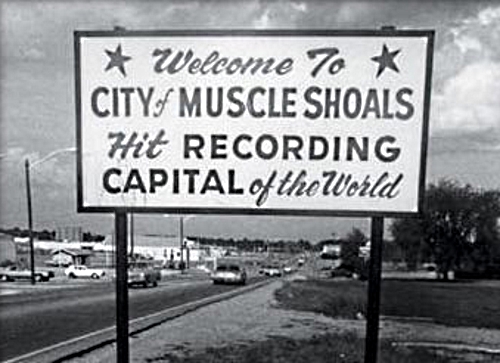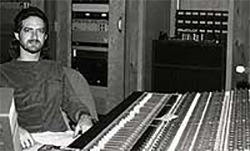
Simon South, Simon North
Despite the frenetic pace of the Traffic tours, the experience helped Hood and Hawkins hone their chops for their next superstar sessions. When Paul Simon ventured into Muscle Shoals, he had four seasoned pickers ready to pounce on him.
“When he come down here to our turf, we jumped right in and knocked his hat in the creek,” says Johnson. “This wasn’t his usual style of recording, where he gets to call all the shots.”
Recalls Hawkins, “He had heard ‘I’ll Take You There’ by the Staples, and thinking it was Jamaican backing, he called Stax to find out where it was done. Then he called us, planning to come down for just one tune, ‘Take Me to the Mardi Gras.’ Well, we knocked that out in two takes, and he was just amazed.
“He started playing some other songs, we told him which ones we liked, and we cut them,” Hawkins continues. “That’s why we got co-production credits.”
Those sessions also produced “Kodachrome” and “Loves Me Like a Rock.” But when he invited the rhythm section to come to New York for “Still Crazy After All These Years,” the magic dissolved. Simon reverted to total control mode, and progress on the tracks slowed to a crawl.
“He made us so paranoid that we were afraid to play,” laments Hood.
Heartland Platinum Rock
If Paul Simon seemed a bit intellectually aloof, Bob Seger connected on a gut level. His association with the ‘Bama boys stretches back to 1972, and the Detroit rocker recorded many of his top hits in Muscle Shoals, including “Mainstreet,” “Old Time Rock & Roll,” “We’ve Got Tonight” and “Katmandu.”
“He’s a real nice guy but he’s not going to make it big,” was David Hood’s first impression. But he soon changed his mind.
“By the time of “Katmandu” he was getting the point across about what kind of records he wanted to make. Before that, we were throwing in R&B licks. Everybody wasn’t thinking in the same direction.”
But that blistering, stuttering rocker turned things around. “I remember on that song we just kept going and going,” recalls Barry Beckett. “I had blisters coming up on my fingers, and Roger had bleeding blisters on his. But we kept on going until we knew it was right. It was hard gut rock and roll.”
In later years, according to Hawkins, Seger’s surging success began to affect his behavior in the studio.
On occasion, during the session for “Against the Wind,” his easygoing demeanor would be frozen by moments of crisis. “He would have trouble making up his mind,” says Hawkins. “He called it ‘platinum paranoia.’”
Turn Toward Production
In the late ‘70s and into the early 1980s, the rhythm section members became increasingly involved in production, most notably Beckett who by 1980 already had credits on projects by Dire Straits, Bob Dylan, Stephen Stills, John Prine and Delbert McClinton.
But since he often plays on the albums he is producing (or co-producing), Beckett confesses he often treads on the border of musical schizophrenia. “It’s discipline,” he maintains, “that’s all it is. One way you turn the switch, you’re a musician, the other way, you’re a producer. But as a producer, you have to look back at yourself as a musician-but also as a producer, too. So, it’s weird. When I’m producing, I try not to build around what I’m playing. I’ll build around something else, then add in what I can.”
Asked for his advice to aspiring studio keyboard players, Beckett took a long, thoughtful pull on a cigarette before answering. “When I first came up here, I threw in every lick I could think of. I was going against rule number one, which is you only play what you need to support the artist. (Note: For an example, listen to the astonishing interplay between Beckett’s piano and Dylan’s voice on “Slow Train Coming.”)
Beckett continues, “So I was going against the artist, playing right on top-which is all wrong. It’s not time to show off unless the producer pushes the button and says, ‘Okay, now show off.’ You have to feel the intensity level of the artist, and support that, and also anticipate when the artist is going to change.”
Working together for so long, says Beckett, has helped the Muscle Shoals section achieve an intuitive “feel” for each artist. “Working as a section, we have the time to learn how the other guys think. But we have to watch out.”
“The better we get, the more we’re in danger of becoming mechanical about it. If we get dead on perfect every time, it could be a problem.”
Of course, other rhythm sections-in New York, Los Angeles, Detroit, Memphis and Nashville-also developed this close camaraderie, and made superb records.
But likely no other group can claim such diversity of styles, and such a high percentage of mega-hit records—scores of which are still selling and getting steady airplay decades later.
What’s the secret here?
The isolation and small town atmosphere could be a factor. “Through the years we’ve been able to draw energy from our roots,” says Hawkins. “And we’ve been able to keep it all moving in a positive direction. If we were in New York, we’d be expending most of our energy just trying to get in the door. Here, we put that energy into making hit records.”
Surrounded by walls laden with gold and platinum records, Barry Beckett echoes Hawkins’ sentiments, then adds a final note of personal conviction.
“Trust is a big part of it. We have a family here, instead of going it alone. Of course, we were lucky to have the right teachers in people like Rick Hall, and people to help along with way like Jerry Wexler. But mostly we made it because we stuck together as a unit and trusted each other.”
He pauses, looks away, then looks back straight in and says quietly: “Also, we wanted it bad, real bad.”
Muscle Shoals Studios Equipment List
Original Equipment
Console: Universal Audio 10-channel tube, later upgraded to Flickenger 16-channel and then MCI 24-channel with automation
Multitrack recorders: Scully 8-track, eventually upgraded to MCI 24-track
Mastering recorders: Ampex mono and Scully 2-track
New Muscle Shoals Sound Studios, 1978 – 80 era

Studio A
Neve 8068 (32 input) console
JH114 24-track recorder
Ampex ATR-102 2-track recorder
Audiocon room monitors (JBL loaded)
BGW and Crown monitor amplifiers
MDM-4 nearfield monitors
Lexicon Prime Time digital delay
Urei 1176 and dbx 160 compressor/limiters
Studio B
Neve 8088 (40 input) console
JH114 24-track recorder
Studer A80 and B67 2-track recorders
Audiocon room monitors (JBL loaded)
BGW and Crown monitor amplifiers
MDM-4 near field monitors
Lexicon 224 digital reverb
EMT (4) and Audion (1) plate reverbs
Live echo chamber (17x12x8)
“Floating” Effects Rack
ADR sweep equalizer
Orban Parasound parametric EQ
ADR Vocal Stressor
Eventide Harmonizer
Eventide Instant Flanger
Kepex (6) and Gain Brain (4)
Marshall Time Modulator
Lang EQ
Go here to read “Muscle Shoals Part II” by Bruce Borgerson.
